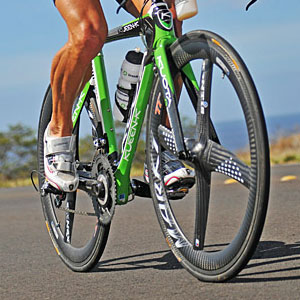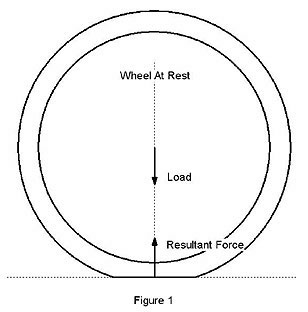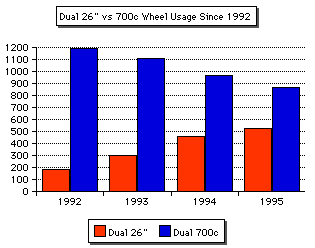What’s in a tire?

Elsewhere on Slowtwitch (link at this article’s terminus) you can read about the basics of what causes rolling resistance in cycling tires. This article touches on some of the factors that affect the overall “speed” of a particular tire or wheel choice. Here we’ll delve further into the construction of tires and how the various features affect the overall performance.
TIRE CONSTRUCTION
There are 3 main features in the construction of a tire that determine how well the tire performs. These features are the casing (or the fabric, that the tire is made from), the tread (the “rubber” interface between the tire and the road), and any “protection” devices such as puncture belts or sidewall protection. As we saw in Part I of this series, rolling resistance is largely determined by the loss of energy in deformations of the tire in the contact patch. Specifically, it’s the difference in energy put into the leading portion of the contact patch by the road and the energy returned to the road in the trailing portion. It’s the material properties and geometries of the 3 tire features mentioned above that largely determine how much of the energy is absorbed (and is “wasted” by just heating the tire) and how much is returned.
The construction of pneumatic tires, such as used on bicycles, is actually a fairly elegant application of textile engineering. That’s right…tires are basically just specially constructed pieces of fabric. We could spend a lot of time going through all the different details of how and why tires are formed the way that they are, but for the purposes of this discussion I’m going to limit it to the portions of the design that the user has an ability to choose between. It's important to note that this discussion applies to tires of both tubular and clincher type construction.
The Casing
Bicycle tire casings are generally composed of 2 types of material; nylon or cotton fibers. For some special cases, the casing fabric is made from more exotic materials such as silk. Instead of being interwoven, the fabric threads are arranged in parallel rows and encased in a matrix of rubber. A sheet of this fabric is called a “ply” and the casing is composed of at least 2 sheets on top of each other and arranged such that the fabric strands in each ply are at an angle to each other, or “on a bias”. This is the origin of the term “bias ply tire.”
The main feature of these fabrics that determines their flexibility (and thus how much energy is absorbed in the contact patch) is the thickness. The way that the thickness of the fabric used in a particular tire is designated is by TPI or “Threads Per Inch”. The thinner the individual threads are that are used to create the fabric, the more threads there are “per inch” when measured across them. Therefore, a tire casing that uses 300 TPI material is much thinner than a casing that uses 60 TPI. The thicker the material in the casing, the more difficult it is to deform and the more energy it takes to flex it a given amount. This means that more energy will be “lost” during the contact patch deformation through “internal friction”, or hysteresis, as was discussed in the first article of this series. One thing to be careful with when determining the TPI of a particular tire is to keep in mind that some manufacturers of tires with many layers of plies “add up” the total number of threads for all the plies in the stack-up. For example, if a tire has 4 plies of 60TPI material in the tread area, they’ll report the tire as having a “240 TPI casing”, when in fact it’s only a 60 TPI casing that’s actually made even thicker by having more than 2 plies in the casing. Obviously, that sort of tire will not be anywhere near as flexible as a casing made from only 2 plies of a true 240 TPI material, but it might be truly “bulletproof”!
Aside from the thickness of the casing material, the materials themselves can have differing energy losses that are attributable to the characteristics of the material itself. For example, silk is considered to have the lowest loss characteristics, with cotton, polyester, and nylon casing materials in general having higher inherent loss characteristics, but still fairly low. Woven materials, such as polyester or Kevlar belts have typically have higher losses than the casing materials.
The Tread
The tread of a tire is the rubber interface that serves as the connection between the tire casing and the road surface. The tread is relied upon to provide adequate friction with the road surface so that driving and cornering forces can be transmitted into it. The design and composition of the rubber compounds that make up the tread rubber on high performance tires is a delicate balance of sometimes competing requirements. Ideally, a tread rubber compound will have very high friction properties, yet not absorb much energy when flexed at the contact patch. Natural rubber (unfilled) is too soft to perform either of these jobs very well and so additives are used to modify the properties to better suit the demands. For a long time, the only additive used for this purpose was carbon black, or microscopic pieces of carbon. Carbon black added to the rubber compound improves the wear and friction properties of the rubber. More recently, silica has been used as an alternative to carbon as a filler in tire rubber compounds. The advantage of silica as a filler material is that it allows the rubber compounds to generally have lower internal energy losses from flexing, thereby improving the rolling resistance properties. Also, it allows tires to be made in all those cool colors we see nowadays! The main drawback of silica as a filler is that its frictional performance (i.e. road grip) in wet conditions is typically poorer than rubber compounds with carbon fillers.
Not only does the composition of the rubber tread affect the energy losses attributable to the tread, but its geometric properties affect it as well. Like the casing material, the thickness of the tread will determine how easy it is to flex the tire. Although a thicker tread material will last longer and not wear out as easy, it won’t have as low of a rolling resistance as a thinner tread of the same material. This is why “high performance” tires not only are constructed of thin casing material, but typically have thin tread as well. In addition to the thickness of the tread, the width of the tread area can affect a tire’s performance. For tires that have a separate tread material glued onto the casing, the width of the tread rubber, and how much of the casing it covers, can be important to the rolling resistance of a tire. Another “geometric” property of tread is whether or not it is smooth or “grooved” in some way. For narrow bicycle tires on pavement, even in wet conditions, tread grooves don't provide an advantage and in some cases may actually result in worse performance from the tire, both in rolling resistance and cornering grip.
Protection
Many tires boast the addition of layers of various materials such as Kevlar or Vectran as added protection against punctures or sidewall cuts. These “puncture belts” can be a valuable addition to tires used in certain “adverse” environments, but that protection is added at the cost of the additional layers making the tire slightly stiffer, and thus having a higher rolling resistance than if the extra layers are left out. Also, unlike the unwoven plies that make up the tire casing, these protection layers are typically made from woven materials. The friction of the threads in these fabrics where the threads interweave can cause additional energy losses.
Whether or not to use a tire with these types of protection layers (and to what extent) is a careful decision that the user needs to make based on the likelihood of a puncture or cut occurring during the event and its affect on the outcome vs. the amount of risk of the failure occurring that the rider is comfortable with accepting. Like most everything in tire selection, this tradeoff typically comes down to speed vs. robustness. There is a great technical presentation on the Vittoria tires website that illustrates the structures discussed above. You can find it here.
Next week we'll talk about what goes inside your tire, namely, your inner tube.



